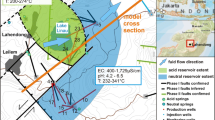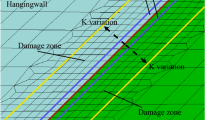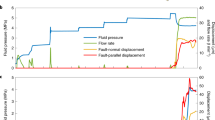Abstract
The impact of inclined faults on the hydrothermal field is assessed by adding simplified structural settings to synthetic models. This study is innovative in carrying out numerical simulations because it integrates the real 3-D nature of flow influenced by a fault in a porous medium, thereby providing a useful tool for complex geothermal modelling. The 3-D simulations for the coupled fluid flow and heat transport processes are based on the finite element method. In the model, one geological layer is dissected by a dipping fault. Sensitivity analyses are conducted to quantify the effects of the fault’s transmissivity on the fluid flow and thermal field. Different fault models are compared with a model where no fault is present to evaluate the effect of varying fault transmissivity. The results show that faults have a significant impact on the hydrothermal field. Varying either the fault zone width or the fault permeability will result in relevant differences in the pressure, velocity and temperature field. A linear relationship between fault zone width and fluid velocity is found, indicating that velocities increase with decreasing widths. The faults act as preferential pathways for advective heat transport in case of highly transmissive faults, whereas almost no fluid may be transported through poorly transmissive faults.








Similar content being viewed by others
References
Adler PM, Thovert J-F, Mourzenko VV (2009) Percolation, and faults and fractures in rock. In: Meyers RA (ed) Encyclopedia of complexity and systems science. Springer, New York, pp 6504–6518
Bächler D, Kohl T, Rybach L (2003) Impact of graben-parallel faults on hydrothermal convection—Rhine Graben case study. Phys Chem Earth 28:431–441
Barton CA, Zoback MD, Moos D (1995) Fluid flow along potentially active faults in crystalline rock. Geol 23(8):683–686
Blessent D, Therrien R, MacQuarrie K (2009) Coupling geological and numerical models to simulate groundwater flow and contaminant transport in fractured media. Comput Geosci 35:1897–1906
Blöcher MG, Cacace M, Lewerenz B, Zimmermann G (2010) Three dimensional modelling of fractured and faulted reservoirs: techniques and application. Chem Erde 70(S3):145–153
Cacace M, Blöcher G, Watanabe N, Moeck I, Börsing N, Scheck-Wenderoth M, Kolditz O, Huenges E (2013) Modelling of fractured carbonate reservoirs—outline of a novel technique via a case study from the Molasse Basin, southern Bavaria (Germany). Environ Earth Sci. doi:10.1007/s12665-013-2402-3
Cacas MC, Ledoux E, de Marsily G, Tillie B (1990) Modelling fracture flow with a stochastic discrete fracture network: calibration and validation 1. The flow model. Water Resour Res 26(3):479–489
Diersch H-JG (2002) FEFLOW finite-element subsurface flow and transport simulation system. User’s Manual/Reference Manual/White Papers, Release 5.0. WASY GmbH, Berlin
Diersch H-JG, Kolditz O (2002) Variable-density flow and transport in porous media: approaches and challenges. Adv Water Resour 25:899–944
Eisbacher GH (1996) Einführung in die Tektonik. Enke, Stuttgart
Erhel J, de Dreuzy J-R, Poirriez B (2009) Flow simulation in three-dimensional discrete fracture networks. SIAM J Sci Comput 31(4):2688–2705
Graf T, Therrien R (2008) A method to discretize non-planar fractures for 3D subsurface flow and transport simulations. Int J Numer Methods Fluid 56(11):2069–2090
Herbert AW (1996) Modelling approaches for discrete fracture network flow analysis. Dev Geotech Eng 79:213–229
Ingebritsen SE, Sanford WE (1998) Groundwater in geologic processes. Cambridge University Press, UK
Kaiser BO, Cacace M, Scheck-Wenderoth M (2013) 3D coupled fluid and heat transport simulations of the Northeast German Basin and their sensitivity to the spatial discretization: different sensitivities for different mechanisms of heat transport. Environ Earth Sci, under revision (this issue)
Kalbacher T, Mettier R, McDermott C, Wang W, Kosakowski G, Taniguchi T, Kolditz O (2007) Geometric modelling and object-oriented software concepts applied to a heterogeneous fractured network from the Grimsel rock laboratory. Comput Geosci 11:9–26
Kolditz O (1995) Modelling flow and heat transfer in fractured rocks: dimensional effect of matrix diffusion. Geothermics 24(3):421–437
Kolditz O, Diersch H-J (1993) Quasi-steady-state strategy for numerical simulation of geothermal circulation in hot dry rock fractures. Int J Non-Linear Mech 28(4):467–481
Kolditz O, Bauer S, Bilke L, Böttcher N, Delfs JO, Fischer T, Görke UJ, Kalbacher T, Kosakowski G, McDermott CI, Park CH, Radu F, Rink K, Shao H, Shao HB, Sun F, Sun YY, Singh AK, Taron J, Walther M, Wang W, Watanabe N, Wu Y, Xie M, Xu W, Zehner B (2012a) OpenGeoSys: an open-source initiative for numerical simulationof thermo-hydro-mechanical/chemical (THM/C) processes in porous media. Environ Earth Sci 67:589–599. doi:10.1007/s12665-012-1546-x
Kolditz O, Shao H, Görke U-J, Wang W (eds) (2012b) Thermo-hydro-mechanical-chemical processes in fractured porous media. Lecture Notes in Computational Science and Engineering, vol 86, Springer, Berlin. doi:10.1007/978-3-642-27177-9
López DL, Smith L (1995) Fluid flow in fault zones: analysis of the interplay of convective circulation and topographically driven groundwater flow. Water Resour Res 31(6):1489–1503
López DL, Smith L (1996) Fluid flow in fault zones: influence of hydraulic anisotropy and heterogeneity on the fluid flow and heat transfer regime. Water Resour Res 32(10):3227–3235
Løtveit IF (2009) Analytical and numerical studies of fluid reservoirs and fracture development in heterogeneous rocks. Dissertation, University of Bergen
Magri F (2004) Derivation of the coefficients of thermal expansion and compressibility for use in FEFLOW. WASY White Papers 3:13–23
Magri F, Akar T, Gemici U, Pekdeker A (2010) Deep geothermal groundwater flow in the Seferihisar-Balçova area, Turkey: results from transient numerical simulations of coupled fluid flow and heat transport processes. Geofluids 10:388–405
McDermott CI, Randriamanjatosoa ARL, Tenzer H, Kolditz O (2006) Simulation of heat extraction from crystalline rocks: the influence of coupled processes on differential reservoir cooling. Geothermics 35:321–344
Müller C, Siegesmund S, Blum P (2010) Evaluation of the representative elementary volume (REV) of a fractured geothermal sandstone reservoir. Environ Earth Sci 61:1713–1724
Noack V, Scheck-Wenderoth M, Cacace M (2012) Sensitivity of 3D thermal models to the choice of boundary conditions and thermal properties—a case study for the area of Brandenburg (NE German Basin). Environ Earth Sci 67:1695–1711
Press F, Siever R (1995) Allgemeine Geologie. Spektrum Akademischer Verlag, Heidelberg
Pryor RW (2011) Multiphysics Modeling Using COMSOL®: a first principles approach. Jones and Bartlett Publishers, LLC
Si H (2008) Three dimensional boundary conforming Delauney mesh generation. Dissertation, Technische Universität, Berlin
Simmons CT, Fenstemaker TR, Sharp JM Jr (2001) Variable-density groundwater flow and solute transport in heterogeneous porous media: approaches, resolutions and future challenges. J Contam Hydrol 52:245–275
Simms MA, Garven G (2004) Thermal convection in faulted extensional sedimentary basins: theoretical results from finite-element modeling. Geofluids 4:109–130
Thompson ME, Brown SR (1991) The effect of anisotropic surface roughness on flow and transport in fractures. J Geophys Res 96(13):21923–21932
Wang W, Rutqvist J, Görke U-J, Birkholzer JT, Kolditz O (2011) Non-isothermal flow in low permeable porous media: a comparison of unsaturated and two-phase flow approaches. Environ Earth Sci 62(6):1197–1207
Watanabe N, Wang W, McDermott CI, Taniguchi T, Kolditz O (2010) Uncertainty analysis of thermo-hydro-mechanical coupled processes in heterogeneous porous media. Comput Mech 45(4):263–280
Acknowledgments
We thank Björn Lewerenz for very helpful computational support and Philipp Balling for his contributions to visualisation and artwork. We acknowledge valuable advice and support in technical questions concerning OpenGeoSys from Dr. Norihiro Watanabe. Jonathan Banks is thanked for his corrections and editing. Additional thanks go to Dr. Hang Si from the WIAS Institute in Berlin for his help in using his open source meshing software TetGen (Si 2008). The numerical results are visualised by using the open source postprocessor ParaView. Constructive comments and suggestions for improvement by two anonymous reviewers and Prof. Olaf Kolditz are gratefully acknowledged. This work is part of the project GeoEn and has been funded by the German Federal Ministry of Education and Research in the programme “Spitzenforschung in den neuen Ländern” (BMBF Grant 03G0671A/B/C).
Author information
Authors and Affiliations
Corresponding author
Electronic supplementary material
Below is the link to the electronic supplementary material.

12665_2012_2212_MOESM1_ESM.jpg
Fluid pressure evolution through time at the three observation points (a), fluid velocity evolution for observation point 3 (b) and temperature evolution along the three observation points (c), see Figs. 1a, b for their respective location

12665_2012_2212_MOESM2_ESM.jpg
Fluid velocity vectors along the whole fault plane as well as along a horizontal plane cutting the model approximately in the central part during (a) the initial stage and (b) after 0.4 days (~0.01 month) of simulation. Non-scaled vectors represent the velocity direction and the background colours map their magnitudes

12665_2012_2212_MOESM3_ESM.jpg
Fault zone width vs. fluid velocity (black dots) for all model simulations within the sensitivity study for the WFZ in observation point 2, located in the central part of the fault plane

12665_2012_2212_MOESM4_ESM.jpg
Distribution of discrete 3-D isotherms of the temperature differences between model with minimum WFZ and model with maximum WFZ

12665_2012_2212_MOESM5_ESM.jpg
Distribution of isobars of the pressure differences between a model with a dipping fault of 60° and a model with a vertical fault on a horizontal cutting plane at −90 m
Rights and permissions
About this article
Cite this article
Cherubini, Y., Cacace, M., Blöcher, G. et al. Impact of single inclined faults on the fluid flow and heat transport: results from 3-D finite element simulations. Environ Earth Sci 70, 3603–3618 (2013). https://doi.org/10.1007/s12665-012-2212-z
Received:
Accepted:
Published:
Issue Date:
DOI: https://doi.org/10.1007/s12665-012-2212-z




